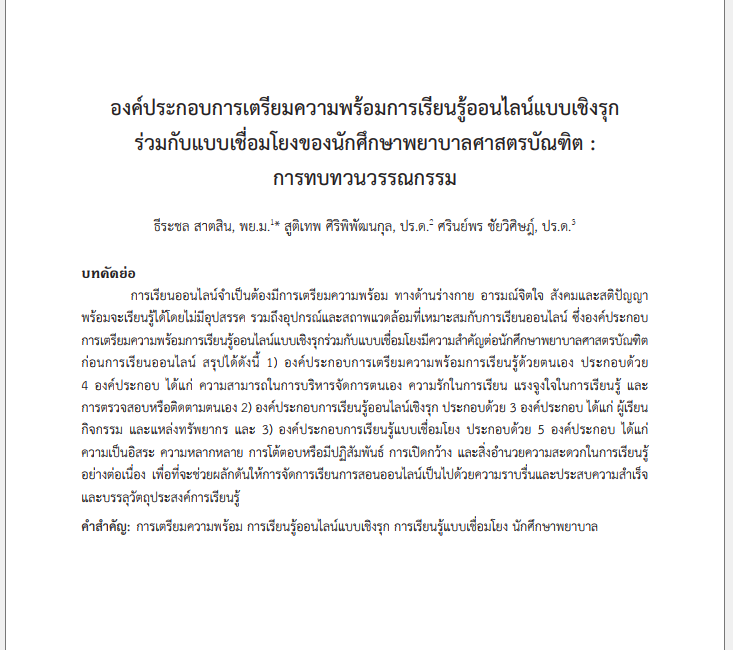องค์ประกอบการเตรียมความพร้อมการเรียนรู้ออนไลน์แบบเชิงรุกร่วมกับแบบเชื่อมโยงของนักศึกษาพยาบาลศาสตรบัณฑิต: การทบทวนวรรณกรรม
คำสำคัญ:
การเตรียมความพร้อม, การเรียนรู้ออนไลน์แบบเชิงรุก, การเรียนรู้แบบเชื่อมโยง, นักศึกษาพยาบาลบทคัดย่อ
การเรียนออนไลน์จำเป็นต้องมีการเตรียมความพร้อม ทางด้านร่างกาย อารมณ์จิตใจ สังคมและสติปัญญา พร้อมจะเรียนรู้ ได้โดยไม่มีอุปสรรค รวมถึงอุปกรณ์และสถาพแวดล้อมที่เหมาะสมกับการเรียนออนไลน์ ซึ่งองค์ประกอบการเตรียมความพร้อมการเรียนรู้ออนไลน์แบบเชิงรุกร่วมกับแบบเชื่อมโยงมีความสำคัญต่อนักศึกษาพยาบาลศาสตรบัณฑิตก่อนการเรียนออนไลน์ สรุปได้ดังนี้ 1) องค์ประกอบการเตรียมความพร้อมการเรียนรู้ด้วยตนเอง ประกอบด้วย 4 องค์ประกอบ ได้แก่ ความสามารถในการบริหารจัดการตนเอง ความรักในการเรียน แรงจูงใจในการเรียนรู้ และการตรวจสอบหรือติดตามตนเอง 2) องค์ประกอบการเรียนรู้ออนไลน์เชิงรุก ประกอบด้วย 3 องค์ประกอบ ได้แก่ ผู้เรียน กิจกรรม และแหล่งทรัพยากร และ 3) องค์ประกอบการเรียนรู้แบบเชื่อมโยง ประกอบด้วย 5 องค์ประกอบ ได้แก่ ความเป็นอิสระ ความหลากหลาย การโต้ตอบหรือมีปฏิสัมพันธ์ การเปิดกว้าง และสิ่งอำนวยความสะดวกในการเรียนรู้อย่างต่อเนื่อง เพื่อที่จะช่วยผลักดันให้การจัดการเรียนการสอนออนไลน์เป็นไปด้วยความราบรื่นและประสบความสำเร็จ และบรรลุวัตถุประสงค์การเรียนรู้
เอกสารอ้างอิง
Abd-El-Fattah, S. M. (2010). Garrison's model of self-directed learning: Preliminary validation and relationship to academic achievement. The Spanish Journal of Psychology, 13(2), 586-596.
Atay, B., & Sumuer, E. (2021). College students' readiness for connectivist learning: The development and validation of a scale. The International Journal of Information and Learning Technology, 2, 230-242.
Behar-Horenstein, L. S., Beck, D. E., & Su, Y. (2018). An initial validation study of the self-rating scale of self-directed learning for pharmacy education. American Journal of Pharmaceutical Education, 82(3). 280-286.
Bonwell, C. C., & Eison, J. A. (1991). Active learning: Creating excitement in the classroom. ASHE-ERIC Higher Education Report, Washington DC: School of Education and Human Development, George Washington University.
Chen, S. L., & Fan, J. Y. (2022). Validation of the psychometric properties of the self‐directed
Ditsili,T., Rampai, N., & Siripipattanakul, N. (2021). Development of a blended leaning model by using an active learning method to enhance pre-service teacher education students’ Information and communication technology (ICT) competencies. NRRU Community Research Journal, 15(2), 197-209. [In Thai]
Dorfman, J., Matthews, W. K., Resta, C., & Venesile, C. (2021). Looking into the virtual space: teacher perceptions of online graduate music education. Bulletin of the Council for Research in Music Education (229), 71-90. doi.org/10.5406/bulcouresmusedu.229.0071
Duke, B., Harper, G., & Johnston, M. (2013). Connectivism as a digital age learning theory. The International HETL Review, 2013(Special Issue), 4-13.
Jahani Yalmeh, Z., Zainalipour, H., & Zarei, E. (2020). Designing a higher education curriculum framework based on Connectivism approach. Iranian Evolutionary and Educational Psychology Journal, 2(1), 1-12.
Kapur, R. (2019). Self-directed learning–A case study. Retrieved from Self-Directed Learning - A Case Study (researchgate.net)
Kumar, A. P., Omprakash, A., Mani, P. K. C., Swaminathan, N., Maheshkumar, K., Maruthy, K., . . . Padmavathi, R. (2021). Validation of internal structure of self-directed learning readiness scale among Indian medical students using factor analysis and the structural equation modelling approach. BMC Medical Education, 21(1), 1-13.
Laohajaratsang, T. (2002). Designing e-learning. Bangkok: Chulabook. [In Thai]
Meyers, C., & Jones, T. B. (1993). Promoting active learning strategies for the college classroom. San Francisco, CA: Jossey-Bass.
Petsirasan, R., & Tantrasenerat, K. (2016) A confirmatory factor analysis of self-directed learning readiness scale among nursing students at a university in Nakhon Si Thammarat. Journal of the Police Nurses, 8(2), 182-191. [In Thai]
Ramu, V., Taib, N., & Aziz, N. F. (2020). The attributes of future social learning built environments towards 21st century education in tertiary education. Planning Malaysia Journal, 18(3), 326-337.
Satsin, T., & Wongwiseskul, S. (2021). Lessons learned from online teaching: Challenges for teachers under COVID-19 situations. Journal of The Royal Thai Army Nurses, 22(1), 1-9. [In Thai]
Satsin, T., Diteeyont, W., & Pattanasith. S. (2022). A systematic literature review of factors affecting online learning among nursing students. Vajira Nursing Journal, 25(2), 115-133. [In Thai]
Shen, W.-Q., Chen, H.-l., & Hu, Y. (2014). The validity and reliability of the self-directed learning instrument (SDLI) in mainland Chinese nursing students. BMC Medical Education, 14(1), 1-7.
Timothy, T., Chee, T. S., Beng, L. C., Sing, C. C., Ling, K. J. H., Li, C. W., & Mun, C. H. (2010). The self-directed learning with technology scale (SDLTS) for young students: An initial development and validation. Computers & Education, 55(4), 1764-1771.

ดาวน์โหลด
เผยแพร่แล้ว
รูปแบบการอ้างอิง
ฉบับ
ประเภทบทความ
สัญญาอนุญาต

อนุญาตภายใต้เงื่อนไข Creative Commons Attribution-NonCommercial-NoDerivatives 4.0 International License.




